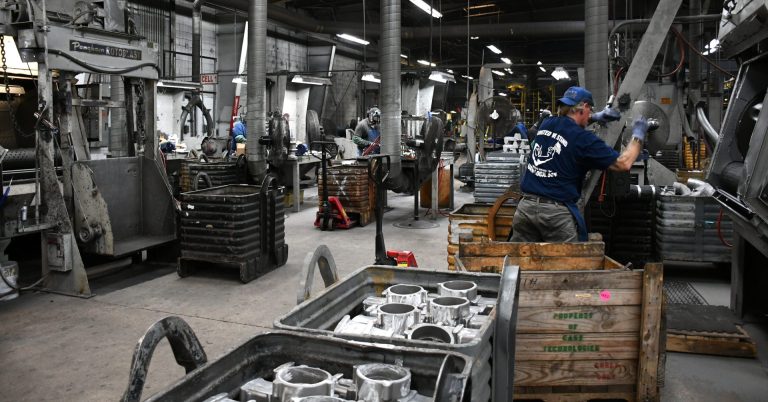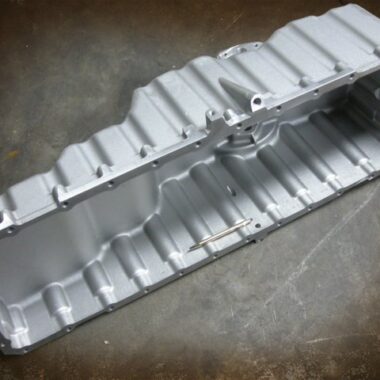Crafting Radiance: Navigating the Globe About Aluminum Casting
Wiki Article
Aluminum Casting Proficiency: Techniques and Devices for Remarkable Outcomes
Grasping the art of aluminum spreading calls for a fragile equilibrium of accuracy, method, and the application of specialized tools. As we explore the intricate methods and tools involved in light weight aluminum casting mastery, one can not neglect the significance of sophisticated pouring and cooling down techniques that can raise the last outcome.
Importance of Correct Melting Methods
Using specific temperature control during the melting process is paramount in guaranteeing the top quality and integrity of aluminum spreadings. The melting of aluminum is an important action in the casting process, as it straight affects the final residential properties of the casted components. Correct melting methods are vital to achieve the wanted metallurgical structure, mechanical buildings, and surface area finish of the light weight aluminum components.
Additionally, surveillance and changing the melt temperature level throughout the process assistance stop overheating, which can trigger grain growth and affect the total top quality of the aluminum spreading. Abiding by accurate melting methods not just improves the high quality of the last item yet likewise improves the performance and cost-effectiveness of the spreading process.
Essential Mold And Mildew Preparation Steps
Proper prep work of mold and mildews is an essential element in the aluminum casting procedure, guaranteeing the effective replication of detailed details and measurements in the last casted components. The crucial mold and mildew prep work steps begin with selecting the proper molding material, such as sand or financial investment spreading products, based on the ins and out of the component and preferred coating. Prior to pouring the liquified light weight aluminum, the mold and mildew dental caries have to be diligently cleansed and dried out to avoid problems in the spreading. In addition, applying mold and mildew coatings can assist boost surface coating and prolong mold life.Moreover, correct gating and risering style are essential in mold and mildew prep work to make certain audio castings with very little problems like porosity and contraction. Eviction system promotes the circulation of molten metal into the mold tooth cavity, while risers aid prevent shrinkage by offering added liquified steel as the casting solidifies. Careful consideration of these aspects throughout mold prep work significantly adds to the high quality and honesty of the final light weight aluminum cast elements.
Advanced Pouring and Cooling Techniques
Carrying out innovative pouring and cooling approaches is pivotal in enhancing the aluminum spreading process for improved performance and quality outcomes. Making use of methods such as vacuum cleaner casting can dramatically reduce porosity in the final item, bring about improved mechanical residential properties. By evacuating the air from the mold and mildew dental caries prior to putting, the risk of gas entrapment is reduced, leading to a denser and even more structurally sound casting.Moreover, using regulated cooling methods, such as water quenching or air cooling, can affect the product's microstructure and mechanical features (about aluminum casting). Rapid cooling can assist attain finer grain frameworks and boosted mechanical properties, making the cast aluminum a lot more appropriate for applications calling for high stamina and longevity
Furthermore, executing directional solidification strategies, where the casting strengthens gradually from one end to another, can aid mitigate internal problems and enhance general component integrity. By meticulously handling the temperature differentials throughout solidification, the development of shrinkage porosity and hot rips can be minimized, causing better castings with improved mechanical performance.
Vital Devices for Light Weight Aluminum Spreading
Enhancing the efficiency and high quality results address of aluminum casting procedures depends heavily on the usage of specific tools made to enhance numerous facets of the casting procedure. One essential device for light weight aluminum spreading is the crucible.One more vital tool is the mold. Molds can be made from products like steel, plaster, or sand and are utilized to shape the molten light weight aluminum into the preferred type. about aluminum casting. Appropriate mold and mildew style and products are essential for attaining exact casting dimensions and surface coatings
In enhancement to crucibles and molds, a heater is an essential tool for aluminum casting. Heating systems warm the steel to its melting point, guaranteeing it is in a state ready for casting. Essential for keeping consistent temperature levels and making sure the light weight aluminum continues to be molten, heaters are readily available in different types, such as electric, gas, or induction heaters, each with its benefits for specific casting needs.
Completing Touches and High Quality Checks
Upon finishing the spreading process, thorough attention to finishing touches and strenuous top quality checks is extremely important to make certain the integrity and precision of the light weight aluminum parts - about aluminum casting. Ending up touches entail the removal of any kind of excess material, such as flash, gating systems, or harsh sides, to accomplish the preferred final form and surface area top quality. This action commonly includes processes like grinding, fining sand, or fired blasting to fine-tune the look and appearance of the actors partsQuality checks are then conducted to verify that the components meet the specific demands and standards. These checks may involve dimensional evaluations using accuracy devices like calipers or coordinate determining equipments to make certain accuracy. In addition, non-destructive screening methods such as ultrasonic screening or X-ray evaluation can be utilized to spot any kind of interior flaws that might compromise the architectural honesty of the components.
Conclusion
Finally, grasping aluminum casting methods and utilizing the right tools is important for attaining exceptional outcomes. Proper melting techniques, mold preparation, pouring and cooling approaches, as well as finishing touches and high find out here now quality checks are vital steps in the casting process. By following these actions very carefully and utilizing the proper tools, one can guarantee a effective and top quality light weight aluminum spreading manufacturing.As we explore the detailed methods and devices entailed in light weight aluminum spreading proficiency, one can not overlook the importance of innovative putting and cooling down methods that can raise the last outcome.Correct prep work of molds is a basic facet in the light weight aluminum casting process, making sure the effective duplication of intricate information and dimensions in the final casted elements. Prior to pouring the molten aluminum, the mold tooth cavity must be diligently cleaned and dried out to stop issues in the spreading.Enhancing the efficiency and high quality results of light weight have a peek at these guys aluminum casting procedures relies greatly on the application of details tools made to maximize various aspects of the spreading procedure.In addition to crucibles and mold and mildews, a furnace is a fundamental device for light weight aluminum casting.
Report this wiki page